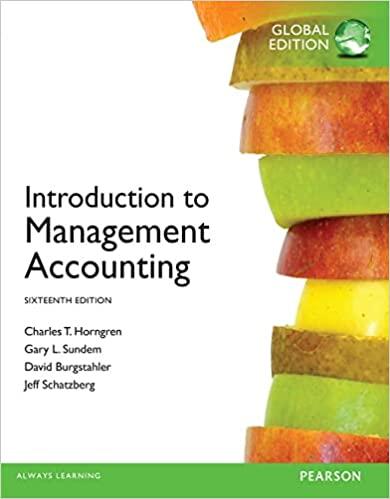Answered step by step
Verified Expert Solution
Question
1 Approved Answer
Please try your best to read the questions well Question 3 (15 marks) Choose the correct answer and show the working to the answer. 3.1



Please try your best to read the questions well
Question 3 (15 marks) Choose the correct answer and show the working to the answer. 3.1 (4 marks) ABC Ltd. is considering buying an equipment to the value of N$2 700 000. The equipment will be used for 50 years after which there is no resale value. The expected return on investment is 15% per annum before depreciation. ABC Ltd.'s cost of capital is 7%. Calculate the residual income of this investment A N$O B (N$270,000) C N$162,000 D N$216,000 3.2 (2 marks) The following is true when you are applying target costing A. To arrive at the selling price you calculate the expected cost of a product then you add a profit margin. B. You account for manufacturing overheads by gathering them into cost pools and then assign them to products using the product's usage of an activity. C. You arrive at the target cost by identifying the market price of a product or service then you deduct the desired profit margin. D. You identify many different markets of the same product then charge different prices to those different markets. 3.3 (2 marks) The following information for producing one unit of product H is available for BH Ltd: Selling price Material costs Conversion costs NS 320 80 60 If BH Ltd uses throughput costing and the time on bottleneck resource is 0.1 hours, calculate the return per factory hour of product H. A N$40 B N$2 400 C N$30 D N$1 800 Page 14 of 19 3.4 (2 marks) The financial analyst of ABC Ltd has presented the following information: Gross profit margin 42% Operating profit margin 28% Gearing (debt/equity) 40% Asset turnover 65% Calculate the return on capital employed A 27.3% B 18.2% C 11.2% D 16.8% 3.5 (2 marks) Which of the following statements best describes the application of lifecycle costing: 1) Life cycle costing is a short term costing technique that identifies costs at the beginning of a product's life cycle. m) Life cycle costing calculates the product's annual profitability by identifying all costs that relates to a product each year. ) Life cycle costing works out the overall profitability of a product by accumulating all product costs over the life of a product iv) Life cycle costing matches the costs of a product at each stage of the product life cycle and charges them in that stage. A (i) and (m) B (ii) only c) and (iv) D() only 3.6 (4 marks) MK Ltd presented the following information: Non-current assets at beginning of the year Depreciation on straight line per year Working capital at beginning of the year Expected profit at year end N$4 000 000 10% N$500 000 N$1 200 000 Page 15 of 19 FACULTY OF ECONOMIC & MANAGEMENT SCIENCES At the end of the year the working capital will be 20% more. The expected profit has already charged depreciation. Using average capital employed, calculate the return on investment (ROI) for this year A 27.59% B 26.37% C 18.39% D 31.58%Step by Step Solution
There are 3 Steps involved in it
Step: 1

Get Instant Access to Expert-Tailored Solutions
See step-by-step solutions with expert insights and AI powered tools for academic success
Step: 2

Step: 3

Ace Your Homework with AI
Get the answers you need in no time with our AI-driven, step-by-step assistance
Get Started


